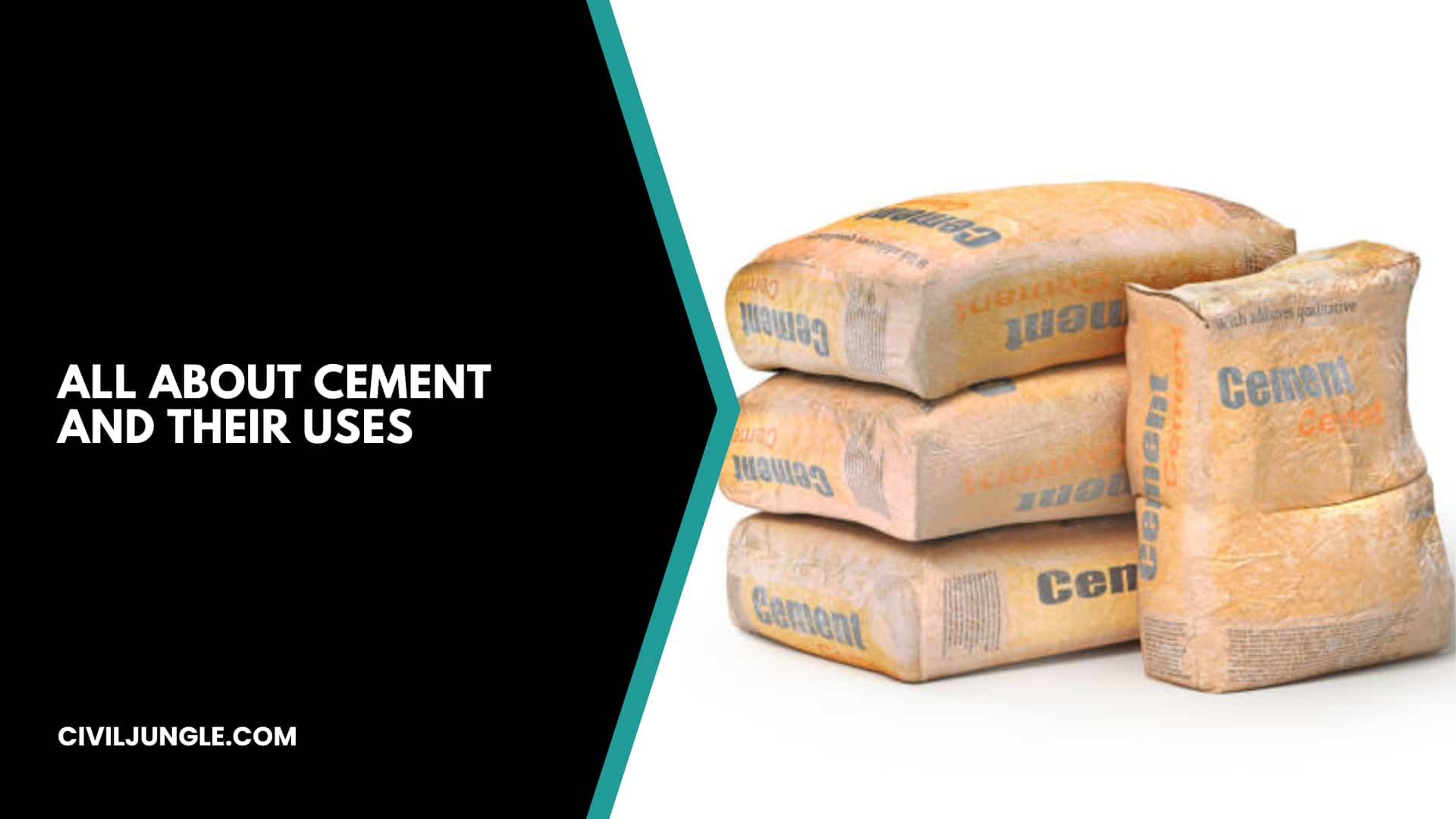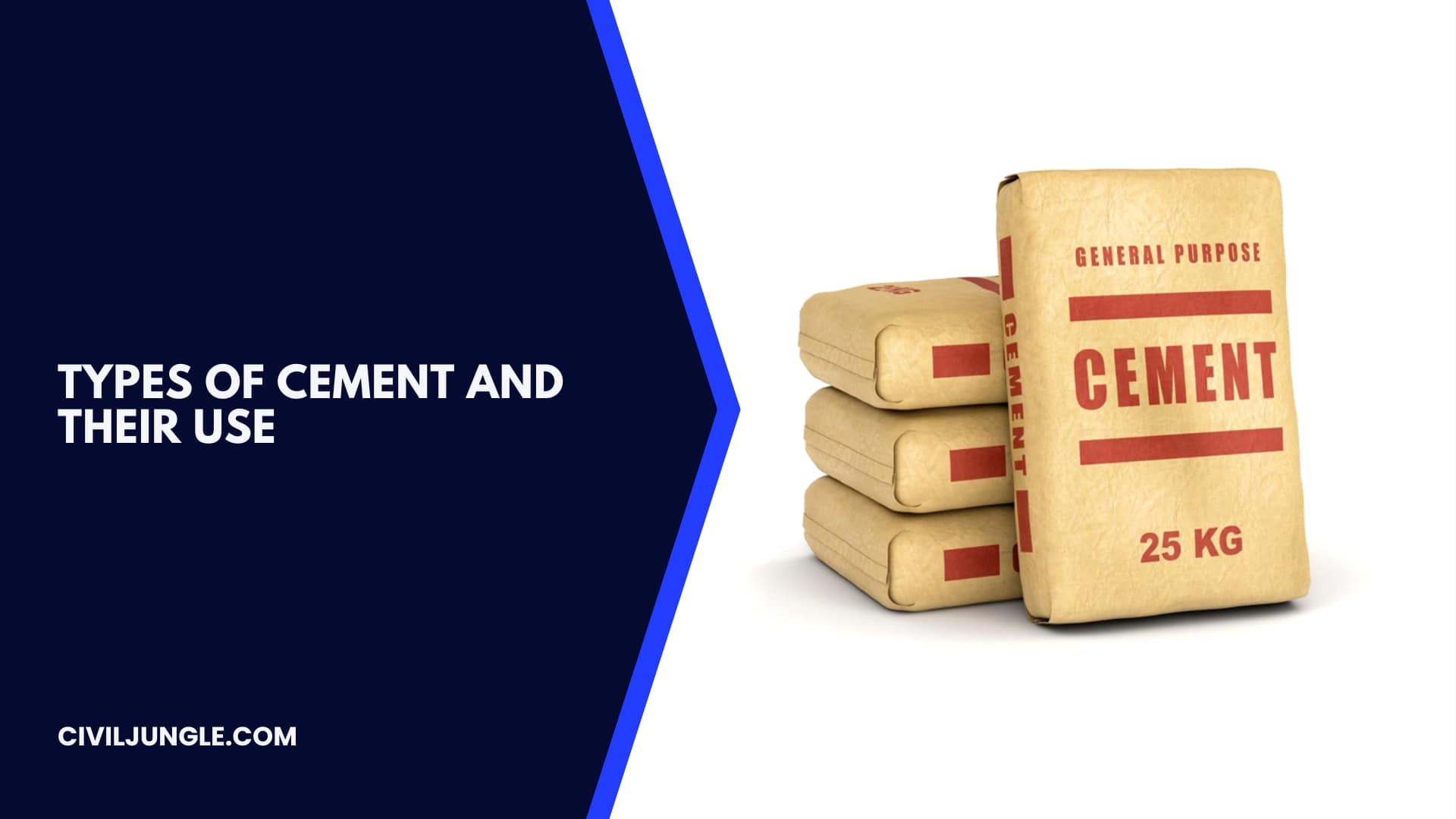Types of Cement and Their Use:
Important Point
Mainly cement is classified into two categories based on setting time and hardening; those categories and uses are written below:
|
Name of the Cement |
Uses |
#1. Hydraulic Cement: |
|
#2. Non-Hydraulic Cement: |
|
There are also thirteen different types of cement-based on their activities and composition; those name and uses are:
|
Name of the Cement |
Uses |
#3. Ordinary Portland Cement (OPC): |
|
#4. Portland Pozzolana Cement (PPC): |
|
#5. Rapid Hardening Cement: |
|
#6. Quick Setting Cement: |
|
#7. Low Heat Cement: |
|
#8. Sulphate Resisting Cement: |
|
#9. Blast Furnace Cement: |
|
#10. High Alumina Cement: |
|
#11. White Cement: |
|
#12. Coloured Cement: |
|
#13. Air Entraining Cement: |
|
#14. Expansive Cement:
|
|
#15. Hydrophobic Cement: |
|
Uses of Hydraulic Cement:
- Swimming Pools.
- Drainage systems.
- Foundations.
- Elevator pits.
- Basement walls.
- Manholes.
- Sealing around concrete and masonry structures.
- Marine applications.
Uses of Non-Hydraulic Cement:
It’s still used for brick and mortar use, and stonework, but is typically found indoors as it needs dry conditions to achieve it’s best structural strength. Due to the difficulties and issues that arise with a long drying period, non–hydraulic cement has taken a back seat.
Uses of Ordinary Portland Cement:
OPC is a general-purpose Portland cement suitable for all uses where the special properties of other types are not required. It is used where cement or concrete is not subject to specific exposures, such as sulfate attack from soil or water, or to an objectionable temperature rise due to heat generated by hydration.
Uses of Portland Pozzolana Cement:
- Used in hydraulic structures, marine structures, construction near the sea shore, dam construction etc.
- Used in pre-stressed and post-tensioned concrete members.
- Used in masonry mortars and plastering.
- As it gives a better surface finish, it is used in decorative and art structures.
Uses of Rapid Hardening Cement:
- For roads, pavements, and highways construction, RHC is used for early strengthening so roads can be made available for use faster than OPC construction.
- In cold weather countries, RHC is used.
- As RHC attains sufficient hardness quickly, formworks can be removed earlier.
Uses of Quick Setting Cement:
- It is used in under water construction.
- It is also used in rainy & cold weather conditions.
- Where, quick strength is needed in short span of time.
- Used higher temperature where water evaporates easily.
- Used for anchoring or rock bolt mining and tunneling.
- Used for fixing concrete steps.
Uses of Low Heat Cement:
- To make the road and workroom surface of factories such as chemical plants and sulphuric acid factories.
- Majorly used in constructing dams large footings, large raft slabs, wind turbine plinths.
Uses of Sulphate Resisting Cement:
Sulfate Resisting Cement is a blended cement designed to improve the performance of concrete where the risk of sulfate attack may be present. It also provides improved durability for concrete in most aggressive environments, reducing the risk of deterioration of the structure and structural failure.
Uses of Blast Furnace Cement:
Pelletized blast furnace slag has been used as lightweight aggregate and for cement manufacture. Foamed slag has been used as a lightweight aggregate for Portland cement concrete. Granulated blast furnace slag has been used as a raw material for cement production and as an aggregate and insulating material.
Uses of High Alumina Cement:
Generally, this refractory product is widely used in sewer infrastructure and marine construction. Besides, it is also used in refractory concretes for furnaces, boilers, kilns, and chimneys. This is due to its strength to withstand very high temperatures with proven durability.
Uses of White Cement:
White Portland cement is used in combination with white aggregates to produce white concrete for prestige construction projects and decorative work. White concrete usually takes the form of pre-cast cladding panels, since it is not economical to use white cement for structural purposes.
Uses of Coloured Cement:
Colored cement is the perfect way to add a splash of color to your patio, walkway, or driveway, and it has other uses as well. It’s best not to try to “match” the mix with the color of your house since it’s difficult to predict the precise shade of the surface once it has dried.
Uses of Air Entraining Cement:
The primary use of air–entraining concrete is for freeze-thaw resistance. The air voids provide pressure relief sites during a freeze event, allowing the water inside the concrete to freeze without inducing large internal stresses. Another related use is for deicer-scaling resistance.
Uses of Expansive Cement:
Expansive cements are used generally to minimize cracking caused by drying shrinkage in concrete slabs and pavements structures and in special circumstances, such as prevention of water leakages. Expansive cements consist of a mixture of Portland cement, expanding agent, and stabilizer.
Uses of Hydrophobic Cement:
These cements are used in construction of dams, spillways, under water constructions. Used in the structures that are exposed to rain or rain puddling, such as green roofs, other kinds of roofs, parking structures, and plazas. Used in drainage system works and manholes.
Cement Types and Uses
Type I: General-purpose cement suitable for use when special properties are not required. Type II: For general use, more especially when moderate sulfate resistance or moderate heat of hydration is desired. Type III: For use when high early strength is desired. Type IV: For use when a low heat of hydration is desired.
Types of Portland Cement
Five types of portland cement are standardized in the United States by the American Society for Testing and Materials (ASTM): ordinary (Type I), modified (Type II), high-early-strength (Type III), low-heat (Type IV), and sulfate-resistant (Type V).
What Is Type 2 Portland Cement Used For?
Uses of Type II Portland Cement. It is used for constructing structures in which water or soil containing less amount of sulfate. This type of cement is used where less heat is required during hydration.
15 Types of Cement
- Ordinary Portland cement (OPC) Ordinary Portland cement is the most widely used type of cement manufactured and used worldwide.
- Portland pozzolana cement (PPC)
- Rapid-hardening cement.
- Extra-rapid-hardening cement.
- Quick-setting cement.
- Low-heat cement.
- Sulfate-resisting cement.
- Blast furnace slag cement.
Types of Cement and Uses
There are several types of cement available, each with different properties and uses. Here are some of the most common types of cement and their uses:
- Portland cement: This is the most common type of cement and is used in a wide range of construction projects, including bridges, buildings, and roads. It is known for its strength and durability, making it an ideal choice for large-scale projects.
- White cement: This type of cement is used primarily for decorative purposes, as it produces a white finish when mixed with water. It is often used in architectural concrete, precast concrete products, and terrazzo.
- Colored cement: This type of cement is mixed with pigments to produce a variety of colors. It is often used in decorative concrete applications, such as stamped concrete, stained concrete, and exposed aggregate.
- Rapid hardening cement: As the name suggests, this type of cement hardens quickly and is ideal for projects that require fast-setting concrete, such as repairs to roads and bridges.
- Low heat cement: This type of cement produces less heat during the curing process, making it ideal for use in large concrete structures that may experience heat-related cracking.
- Pozzolanic cement: This type of cement is made by combining Portland cement with pozzolanic materials, such as volcanic ash or fly ash. It is known for its durability and resistance to chemical attack, making it ideal for use in marine structures and sewage systems.
- Masonry cement: This type of cement is used for brick and block construction. It is typically made by combining Portland cement with lime and sand.
Cement Used in Sewage and Water Treatment Plants Is
Water treatment plants concrete is not usualy exposed to corrosive elements in the water therefore standard cement is used.
Which Cement Is Used for Marine Construction?
The blast furnace slag cement has very low permeability and provides good resistance to chloride and sulphate attack which is present in seawater. The blast furnace slag cement is widely used in the marine structure.
This Type of Cement Is Used in Construction Under Running Water
Pozzolana cement is used for underwater construction. It is extremely water resistant.
Like this post? Share it with your friends!
Suggested Read –
- Types of Tunnel
- What Is Defects in Painting | 18 Types of Defects in Painting | How to Prevent Defects in Painting
- Aggregates | Difference Between Coarse And Fine | How to do Shape and Size Matter in Aggregate
- What Is Transportation Engineering | Major Disciplines of Transportation Engineering | What Do Transportation Engineers Do
- What Is Sewerage System | Types of Sewerage System | Why We Need a Partially Separate System | How Does a Sewage Treatment Plant Work
- What Is Kelly Ball Test | Test Procedure of Kelly Ball Test | Use of the Kelly Ball | Advantages of Kelly Ball Test | Disadvantages of Kelly Ball Test
- What Is Oblique Drawing | Oblique Drawing Examples | What Is Oblique View | Oblique Projection | Oblique Shape | Cabinet Oblique | What Is Cavalier Drawing
Originally posted 2023-04-27 17:05:24.



Leave a Reply